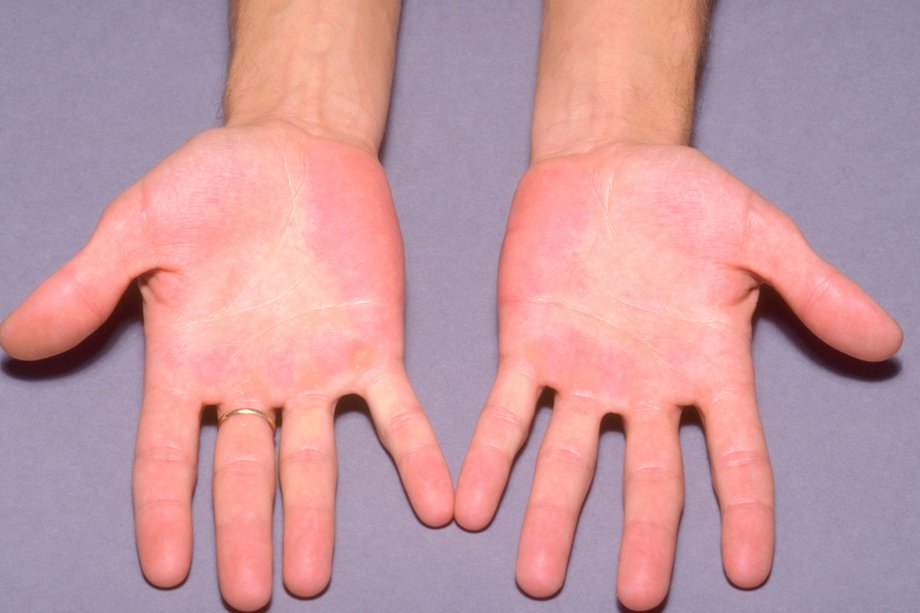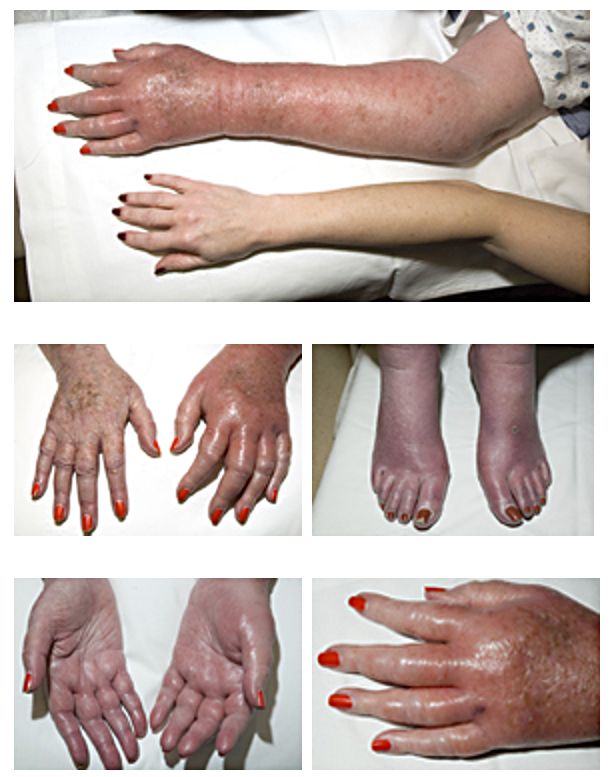Symptoms of erythromelalgia
The three main symptoms of erythromelalgia are heat, pain and redness in the skin.
The feet are most commonly affected, but the hands, arms, legs, ears and face can be too.

The pain can range from mild, with only a minor tingling feeling like pins and needles, up to a severe burning pain, which can be bad enough to make walking, standing, socialising, exercising and sleeping difficult. It can have a significant impact on work or school life.
People with erythromelalgia typically suffer episodes or “flare-ups” of pain lasting from a few minutes to days. The flare-ups usually start as an itching sensation, which worsens to pain, and tender, mottled red skin that feels warm or hot to the touch.
Other symptoms may include:
- swelling of the affected body part
- sweating in the affected area more or less than you usually would
- purple discolouration when there is no flare-up
Triggers for erythromelalgia
Symptoms are usually triggered by an increase in body temperature.
This can happen:
- after exercising
- when wearing warm socks, gloves or tight shoes
- after entering a warm room
- when feeling stressed
- when drinking alcohol or eating spicy food
- when you’re dehydrated
Treatments for erythromelalgia
Elevation and cooling the skin
Cooling or elevating the affected part of the body may help relieve symptoms.
The skin can be cooled using a fan, cool water, a cool surface or cool gel packs.
However, avoid using ice or anything that’s too cold, and don’t soak hands or feet for a long time in cold water. This can lead to hypothermia or skin damage. And there’s also a risk the change in temperature may trigger a flare-up when the affected area warms up again.
Medications for the skin
Some medications that are applied directly to the skin (topical medication) have been found to help relieve the symptoms of erythromelalgia.
These may be in the form of creams, gels, sprays or patches. You may be prescribed a capsaicin cream or patch to make the heat receptors in your skin less sensitive. Lidocaine (a local anaesthetic) may also be prescribed in the form of a cream, gel or spray.
Your doctor will be able to give you more information about these medications and if they’re right for you.
You can also speak to your pharmacist about lidocaine creams.
Medication taken by mouth
A number of different medications taken by mouth (orally) may help to relieve the symptoms of erythromelalgia.
You may need to try several different medications, under the supervision of your doctor, before you find the one or the combination that works best for you.
Your treatment options will also depend on the type of erythromelalgia you have. Many treatments require referral to a specialist centre so benefits and potential side effects can be closely monitored.
The types of medication your doctor may prescribe include:
- dietary supplements – such as magnesium, which can help open up your blood vessels
- aspirin – only used for adults, not for children
- anti-epilepsy drugs – such as gabapentin or carbamazepine
- blood pressure drugs – medication to either open up your blood vessels and increase blood flow, or beta-blockers to help reduce blood flow, depending on the cause of your erythromelalgia
- low doses of antidepressants – such as duloxetine, venlafaxine, amitriptyline or nortriptyline
- prescription-only painkillers
Medications given via a drip
In some cases, when oral medication has not managed to control the symptoms, medicine may be given directly into the bloodstream via a drip (intravenous infusion). Lidocaine, a local anaesthetic that can help nerve-related pain, can be given this way. But how long it works for varies between people.
Your doctor will explain this procedure to you and how you should prepare for it.
Causes of erythromelalgia
In most cases of erythromelalgia, the cause is unknown.
However, it’s sometimes due to another underlying medical condition or a faulty gene inherited from a parent.
Other medical conditions
Erythromelalgia sometimes results from an underlying condition, such as:
- a blood disorder – such as polycythaemia
- nerve damage – for example, caused by peripheral neuropathy
- multiple sclerosis (MS)
- an autoimmune problem – such as lupus or rheumatoid arthritis, where the immune system attacks the body’s own tissues
It may also be caused by certain medications. Your doctor will be able to give you more information on this.
Genetic cause
In some people with erythromelalgia, the disease is caused by a faulty gene. Erythromelalgia can run in families when the faulty gene is passed down from a parent to their child (inherited).
The faulty gene causes changes in the way pain signals are delivered to the brain, increasing or strengthening them.
More information and support
Specialist centres in the UK
For children: Great Ormond Street Hospital for Children Pain Control Service
For adults: National Hospital for Neurology and Neurosurgery Pain Management Centre
Organisations that provide support
Information about you
If you or your child has erythromelalgia, your clinical team will pass the information on to the National Congenital Anomaly and Rare Diseases Registration Service (NCARDRS).
This helps scientists look for better ways to prevent and treat this condition. You can opt out of the register at any time.
Page last reviewed: 26/09/2017
Next review due: 26/09/2020
